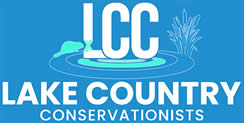Professional Land Management Services
Lake Country Conservationists is able to assist with any and all of your land management needs. We are currently contracted with the DNR treating invasive species on public land. Whether it’s a one time consultations or a full comprehensive management plan that is followed through from start to finish, we are able to assist you. We have extensive experience working with different ecosystems which allows us to provide you with effective management techniques. Below is some more information on why these land services are important
Wisconsin Statute Section 23.22 (1) (c) defines invasive species as "nonindigenous species whose introduction causes or is likely to cause economic or environmental harm or harm to human health."
Humans move organisms around all the time. Sometimes when we bring a non-native species into a new area the species will take over and spread rapidly and widely throughout the area. When this happens, the spread can cause major harm to the native ecosystem or humans. When non-native plants, animals or pathogens rapidly take over a new location and alter the ecosystem, we consider them invasive species.
How They Become a Problem?
One of the reasons that invasive species are able to succeed is that they often leave their predators and competitors behind in their native ecosystems. Without these natural checks and balances, they are able to reproduce rapidly and out-compete native species.
Invasive species can alter ecological relationships among native species and can affect ecosystem function, the economic value of ecosystems and human health.
Humans have created conditions where plants and animals can aggressively invade and dominate natural areas and water bodies in three ways:
- Introducing exotic species (from other regions or countries) who lack natural competitors and predators to keep them in check
- Disrupting the delicate balance of native ecosystems by changing environmental conditions -- e.g., stream sedimentation, ditching, building roads) or by restricting or eliminating natural processes (fire for example); in such instances, even some native plants and animals can become invasive
- Spreading invasive species through various methods. Some examples:
- moving watercraft from waterbody to waterbody without removing invasive plants and animals
- carrying seeds of invasive plants on footwear or pet’s fur
- mowing along roadsides
- importing firewood and leaving in campgrounds
- driving and biking with invasive seeds in tire treads
The net result is a loss of diversity of our native plants and animals as invasive species rapidly multiply and take over. About 42% of the species on the federal Threatened or Endangered species lists are at risk primarily because of invasive species.
Economics
In the United States, expenses associated with ecological damage and control of invasive species were estimated at $137 billion per year in 2001 and have been increasing ever since.
More recent global studies have found that invasive species alone cost a minimum of $35 billion per year in North America, not including the costs of these insects to human health.
Rising human populations, increasing international trade and climate change all will be increasing the likelihood of the spread of current invasives into new areas and the introduction of new problematic species.
In Wisconsin, some industries affected negatively by invasive species include sport and commercial fishing, forestry, agriculture and raw water users including power companies, industrial water users and municipal water plants. These expenses are passed on to Wisconsin consumers, such as in higher water and electric bills.
The Great Lakes sport and commercial fishing industry, valued at almost $4.5 billion and supporting 81,000 jobs, is at risk due to the growing numbers of invasive species present in its waters. For example, invasive round gobies eat the eggs of sportfish such as small-mouth bass, trout and sturgeon in the nearshore areas of Lake Michigan.
There have been negative economic impacts due to the Viral Hemorrhagic Septicemia (VHS) restrictions on baitfish sales and fish hatchery/stocking operations. Other negative impacts include but are not limited to the reduction of property values. One study shows that property values have decreased as much as 19% on lakes infested by Eurasian watermilfoil.
Invasive shrubs such as non-native buckthorns and honeysuckles prevent the regeneration of young trees, causing a long term but very serious impact on forestry in Wisconsin – a $28 billion a year industry with 66,000 jobs. In Wisconsin alone, 2015 spending on invasive species totaled approximately $8.4 million.
Many of the invasive plants that impact our natural areas are also agricultural weeds and are frequently spread along and from corridors that cut through the landscape, like roads, rail lines and utility corridors.
In 2001, Wisconsin Electric Power Company reported that they were spending $1.2 million per year in the control of zebra mussels on their Lake Michigan power plants. These animals congregate on and clog intake and distribution pipes.
Health
Some invasive species may cause significant health problems. For example, a South American strain of human cholera-causing bacteria was found in ballast water tanks of ships in the port of Mobile, Alabama in 1991. Also, sharp zebra mussel shells can cut the feet of unsuspecting swimmers and waders.
Health risks aren't only confined to water-dwelling invasive species. Simply rubbing against wild parsnip with bare skin can cause burned and blistered arms and legs. This roadside and grassland invasive is spreading rapidly in Wisconsin, but few people know of its dangerous impacts.
Invertebrates are increasingly becoming vectors for serious diseases of humans, livestock and wildlife. In Wisconsin, we have recently seen the expanded range of the lone star ticks previously found only to our south. We now have at least six serious tickborne diseases affecting thousands of people per year.
Ecology
The introduction of invasive species disrupts natural communities and ecological processes. This disruption alters the role of competition and predation in many different ways, including ruffe and round goby out-competing native species and the negative impacts that has had on the food web.
Other negative impacts include the displacement of native species with the loss of species diversity and degradation of habitats due to invasive species like garlic mustard, honeysuckle and other shrubs, purple loosestrife and Eurasian watermilfoil among others. These invasive plants and animals also have the potential to be vectors for diseases that threaten the health of the ecosystem. Many of the constraints that invasive species face in their native range (e.g. diseases and pests) are absent in Wisconsin, which allows them to rapidly multiply at the expense of native plant and animal species.
Humans have created conditions where plants and animals can aggressively invade and dominate natural areas and waterways in three ways.
- Introducing non-native species from other regions or countries. The natural competitors and predators that kept them in check in their native range are not found here, allowing the new species to thrive.
- Disrupting the balance of native ecosystems by changing environmental conditions – e.g., stream sedimentation, ditching, building roads, fragmenting forests, warmer and/or shorter winters – or by restricting or eliminating natural processes, for example, fire. In such instances, even some native plants and animals can become invasive.
- Spreading invasive species through various methods, including moving watercraft from waterbody to waterbody without removing invasive plants and animals, roadside mowing, importing firewood and moving construction, logging or recreational gear without cleaning off the mud.
The net result is a loss of diversity of our native plants and animals as invasive species rapidly multiply and dominate forests, grasslands, wetlands and water bodies. About 42% of the species on the federal endangered of threatened or endangered species lists are at risk primarily because of invasive species.
In our waterways, the rapid spread of zebra and quagga mussels shows how profoundly an invasive species can alter the environment. These small mussels with huge appetites for microscopic plants and animals rapidly reproduce and are capable of severely altering their environment by reducing the food supply for native organisms and by enhancing conditions for the rapid growth of blue-green algae and aquatic vegetation.
In our woodlands, garlic mustard can completely cover the ground with first- and second-year plants in a matter of a few years. This European garden herb not only reduces light and nutrient resources needed by native wildflowers, but it is also thought to secrete a chemical into the soil that inhibits the mycorrhizal fungi necessary for tree growth.
Invasives can also alter your recreational activities. Hunters, hikers and birdwatchers can find that they are no longer able to walk in their favorite natural areas. Thorny multiflora rose, dense stands of buckthorn and other invaders fill the understory of once open forests and grasslands. As the habitat is modified by invasive plant species, the wildlife that depends on native species decline as well. Invasive animals such as the mute swan can also change our wildlife opportunities by chasing away waterfowl from the waterbodies they occupy.
Non-native earthworms and generalist native species like white-tail deer tend to increase in weedy habitats, and in turn, they alter soil chemistry and structure and decrease native plant species and increase weedy non-natives. Gardeners who have the Asian jumping worm in their yards may find that worms have altered what they are able to grow.
Fishing outings can result in disappointment when aquatic invasive species modify our lake and stream habitats. Eurasian watermilfoil can clog boat motors and invasive animals such as the rusty crayfish gobble up aquatic plants like underwater lawnmowers, reducing habitat for native fish at every stage of their life cycle. The invading crayfish may even eat the eggs of some of our favorite sport fish. This threatens a national sport and commercial fishing industry that supports 81,000 jobs in the Great Lakes region.



